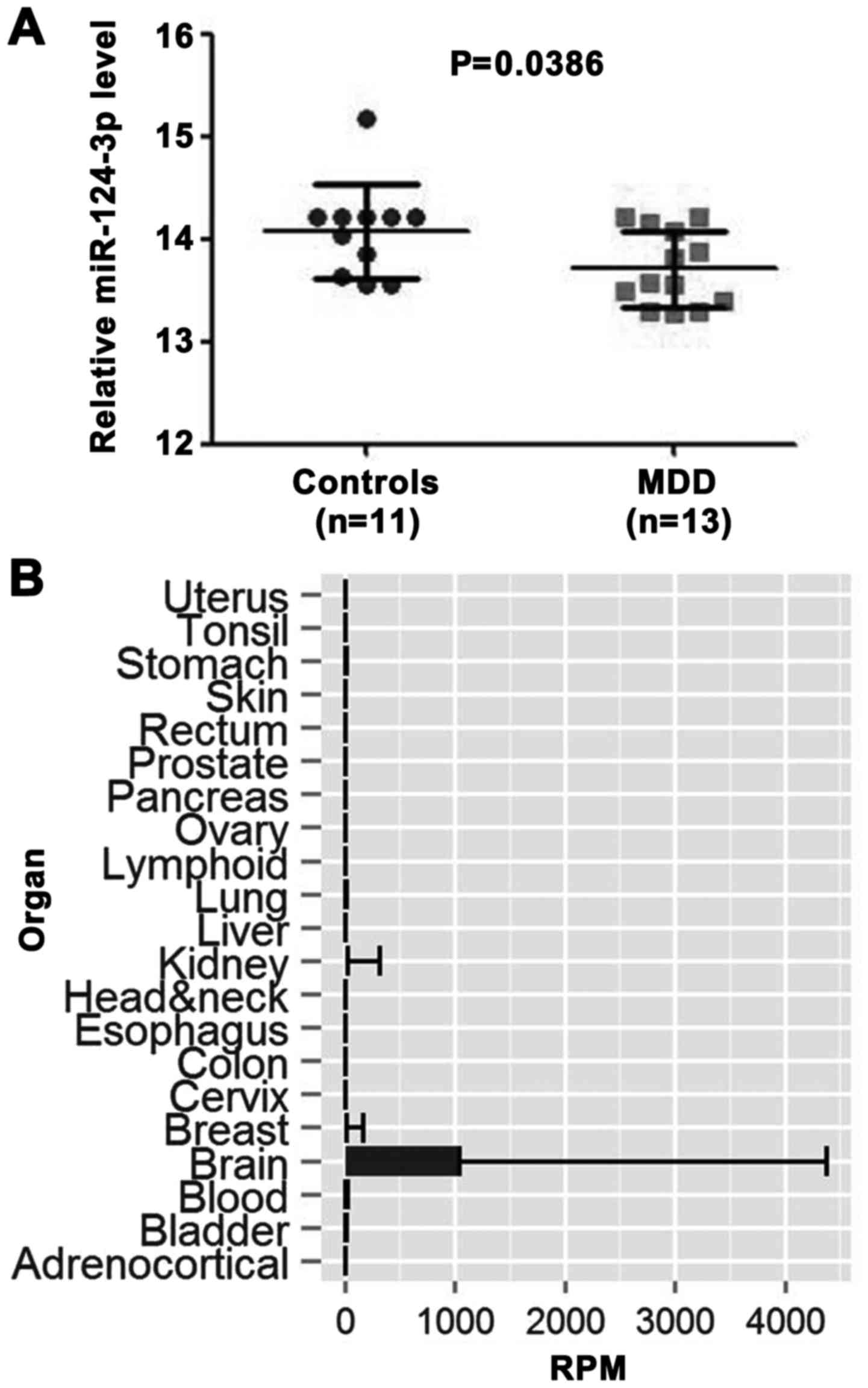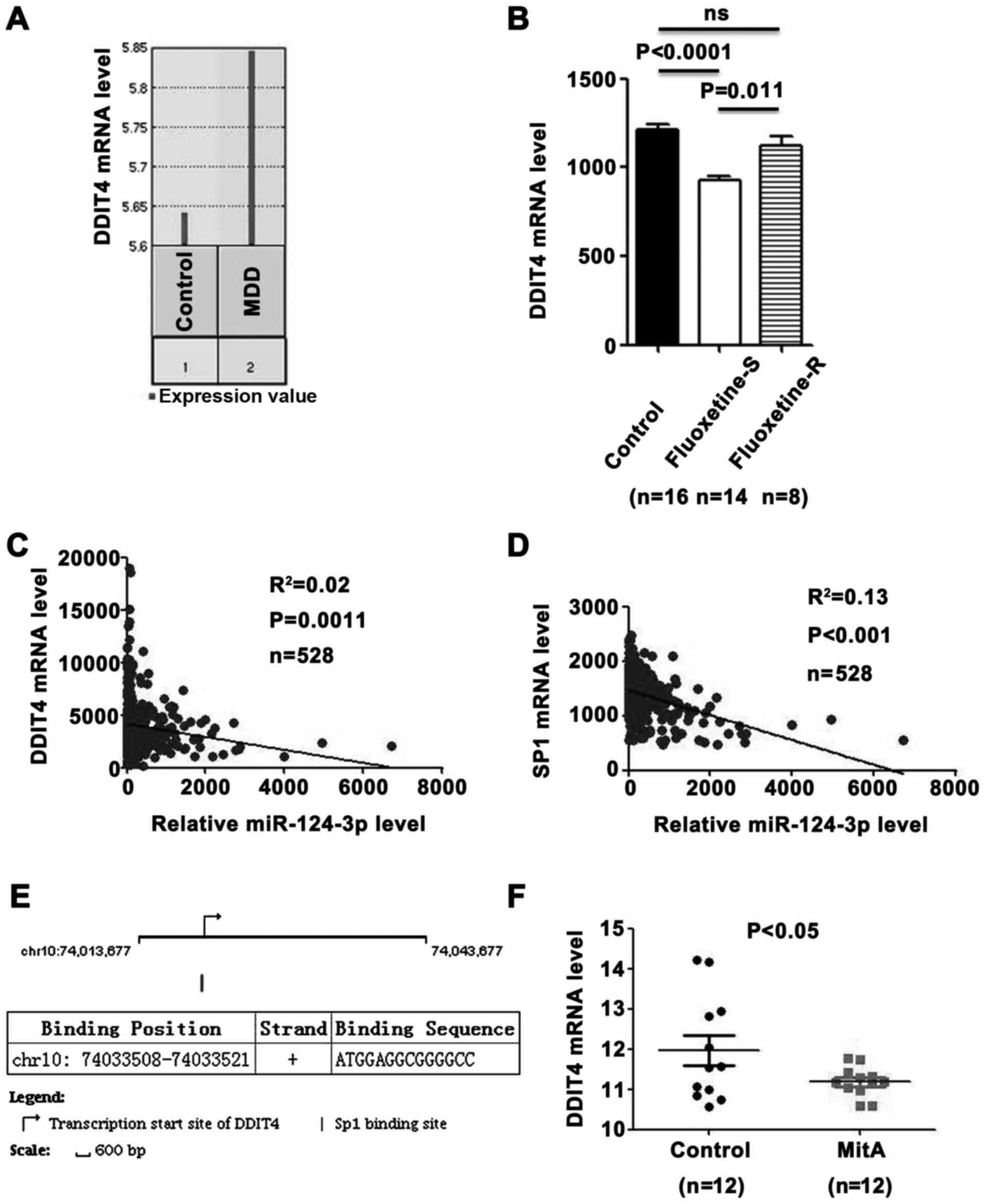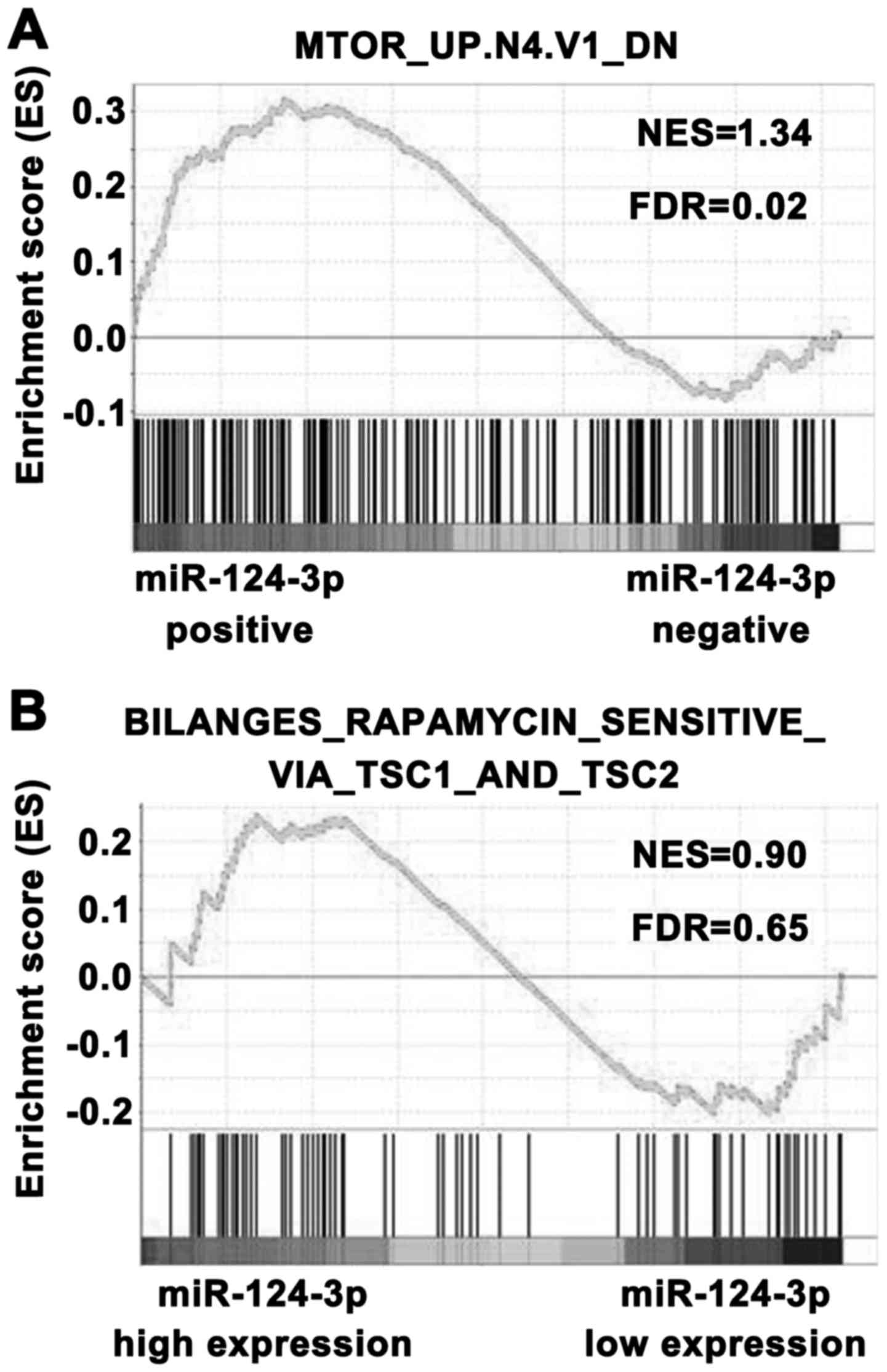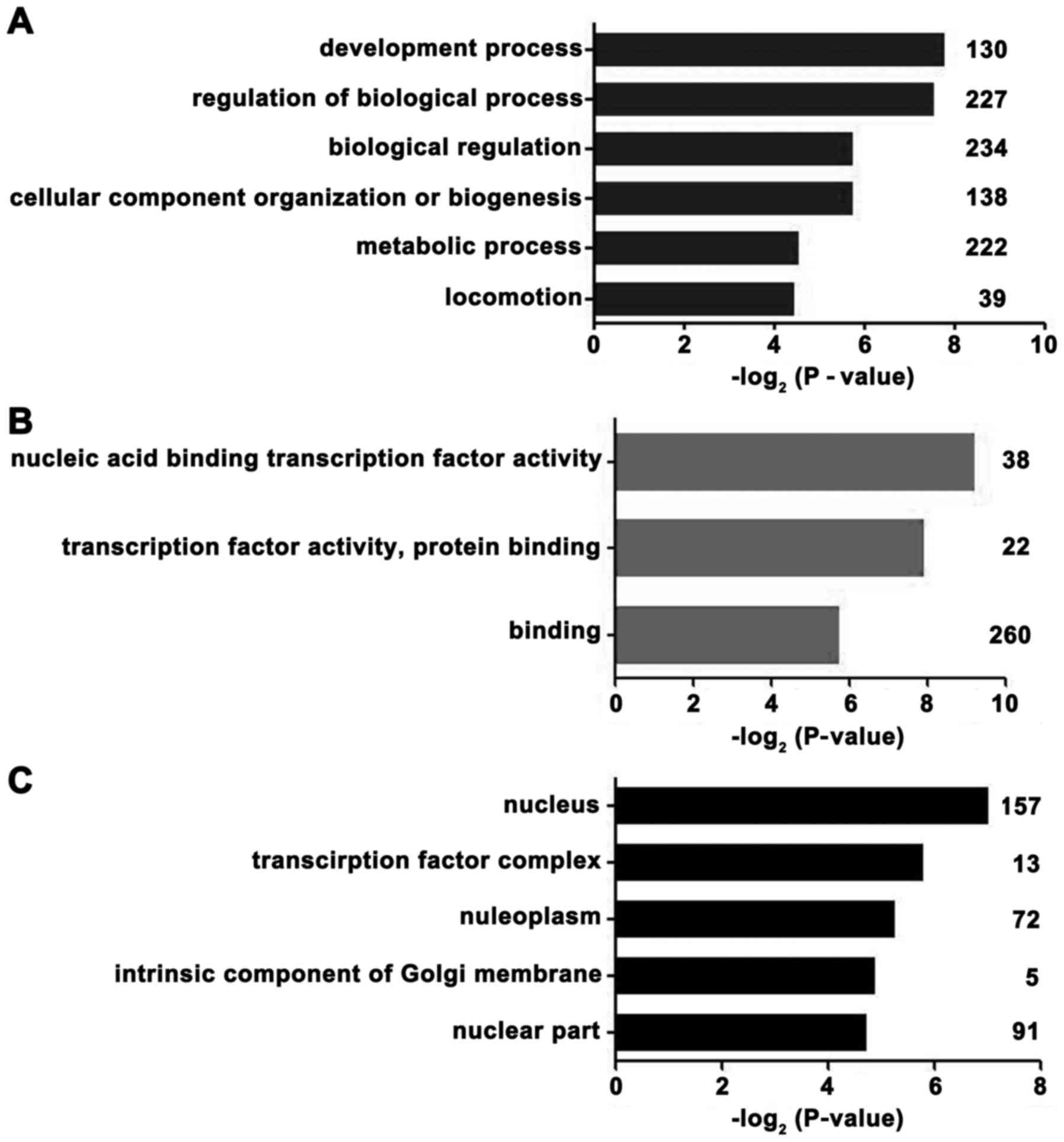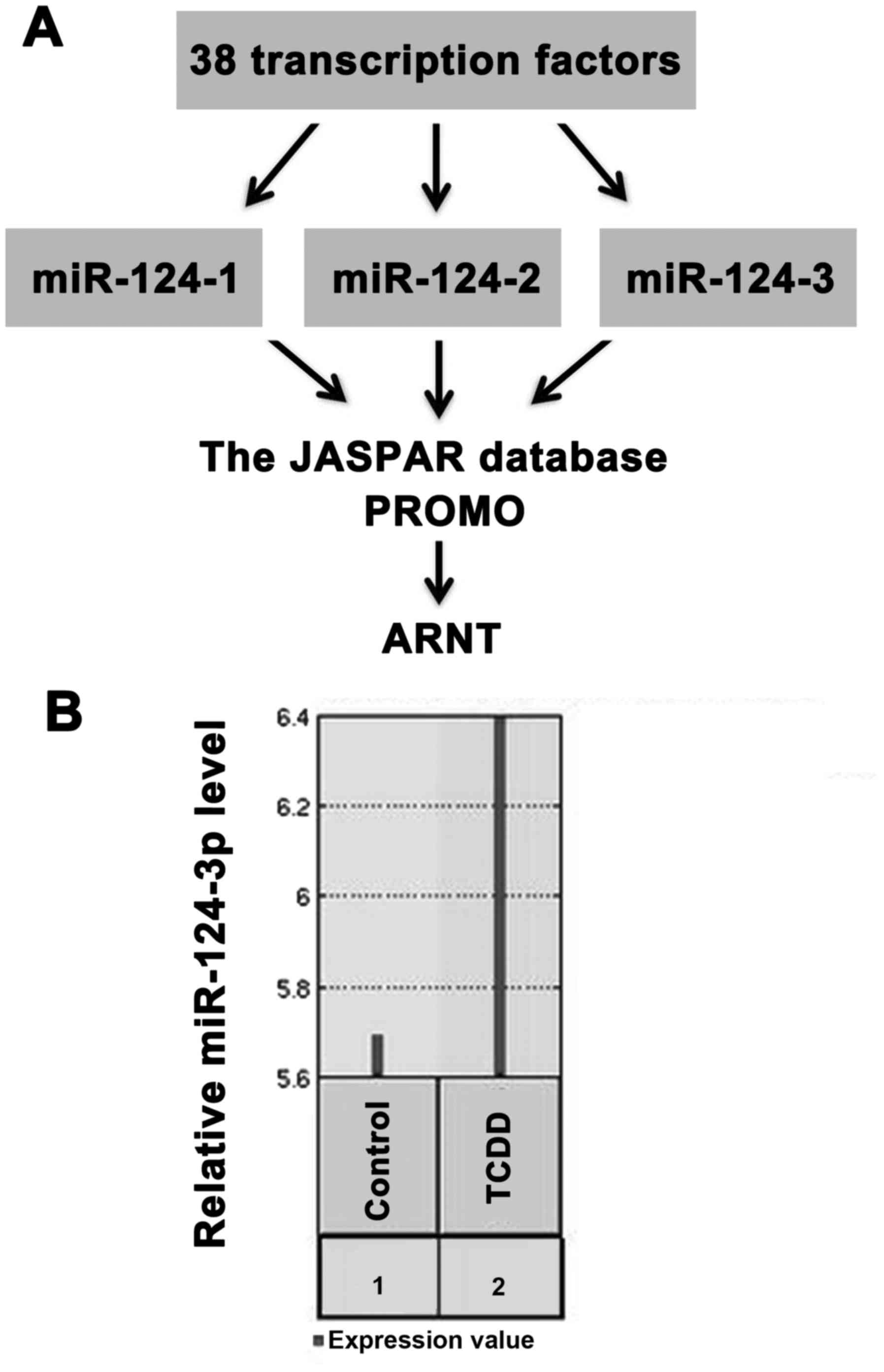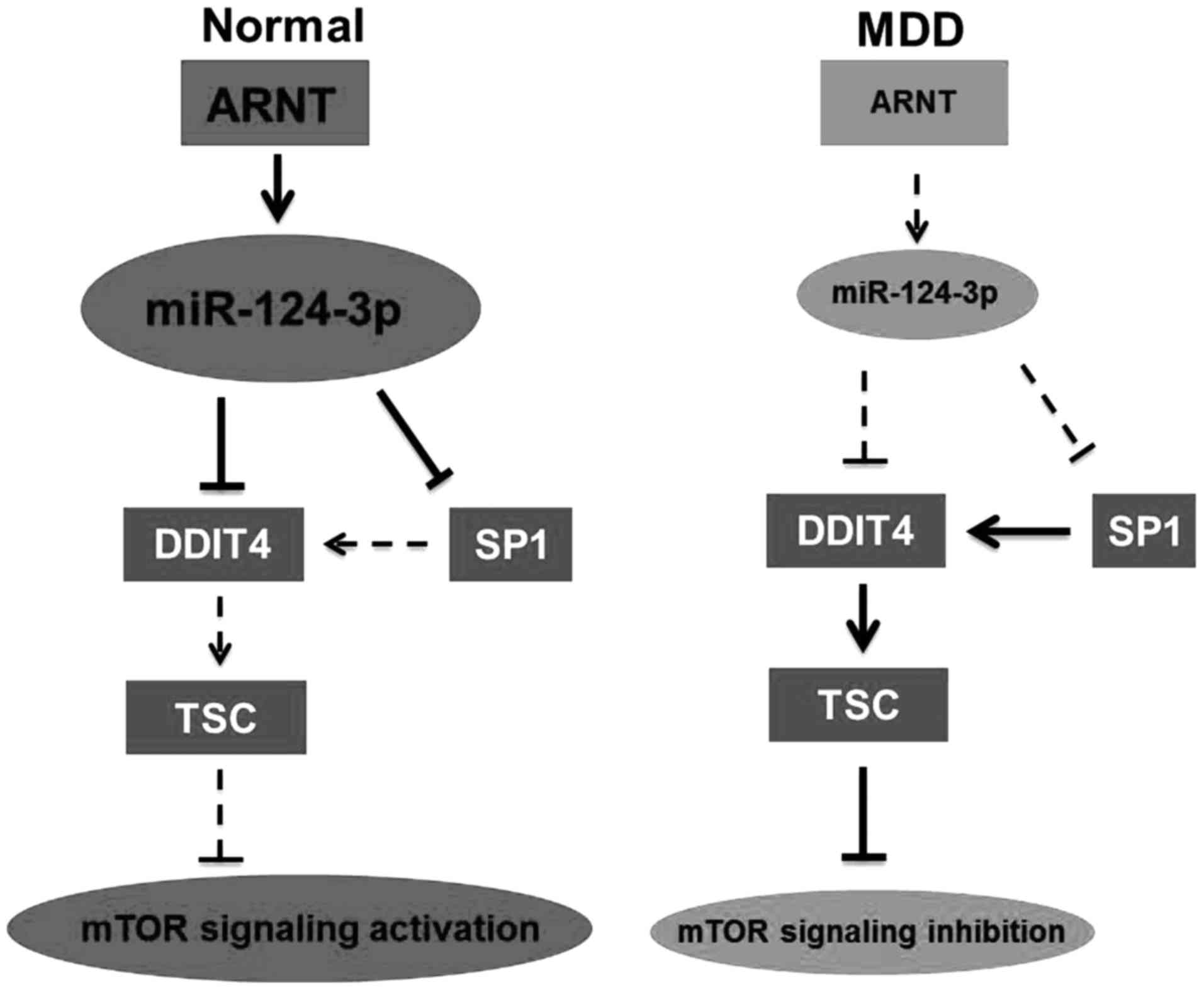Downregulation of microRNA‑124‑3p suppresses the mTOR signaling pathway by targeting DDIT4 in males with major depressive disorder
- Authors:
- Published online on: November 6, 2017 https://doi.org/10.3892/ijmm.2017.3235
- Pages: 493-500
Abstract
Introduction
Major depressive disorder (MDD) is associated with a high degree of morbidity and mortality (1), and is predicted to be the leading cause of disease burden by the year 2030 (2). MDD occurs about twice as often in women than in men (3) and sex difference is the most obvious characteristics for MDD (3,4). An increasing number of sex‑specific biomarkers for MDD have been identified (5). Moreover, male and female mice have demonstrated fundamentally different transcriptional and post‑transcriptional responses to stress, and sex‑specific molecular processes occurred following stress (6). Notably, males demonstrated a very robust transcriptional and post-transcriptional response to stress (6). These findings revealed that the pathogenesis of MDD is markedly different in males and females, and transcriptional and post-transcriptional dysregulation may lead to occurrence of MDD in males. Although these changes were found to correlate with MDD in males, the molecular mechanism remains poorly understood.
MicroRNAs (miRNAs or miRs), a prominent class of small non-coding RNAs, generally exert their functions by binding the 3′ untranslated regions of target mRNA to suppress target gene expression in post-transcriptional regulation and control various biological processes (7). The majority of known mammalian miRNA are expressed in a tissue‑specific manner, cause translational repression and may individually target hundreds of genes (8). miRNAs are highly expressed in neurons, where they regulate the expression of a large number of target mRNA. Neuronal miRNA pathways may create an extremely powerful mechanism to dynamically adjust the protein content of neuronal compartments, even without the requirement for new gene transcription (9,10). Dysregulation of specific miRNA has been observed in patients and animal models of neuro-psychiatric disorders (11–14). In addition, a critical component necessary for miRNA biogenesis, Dicer1, has also been implicated in posttraumatic stress and anxiolytic responses (15,16). With regard to MDD, the evidence supporting miRNA involvement in the pathophysiology and the treatment of the disorder is increasing (17). In addition, numerous studies have implied that miRNA may provide a link between environmental stressors and gene expression (18), and be an important factor involved in the mechanism of depression (19–22). In vertebrates, more distinct miRNAs are expressed in the brain than in any other tissues (23,24). These studies indicate that miRNA may serve an important role in the brain of patients with MDD by acting as the master regulator of gene expression at a post-transcriptional level (25–27). Previous investigations have suggested that miRNA have been involved in several pathways that may contribute to the MDD pathomechanism (27–29). However, how these miRNA contribute to this illness is not well understood.
The present study identified that miR‑124‑3p, an abundant miRNA in the brain, was significantly downregulated in the post-mortem brain BA44 area of males with MDD. The miR-124-3p target gene, DNA damage-inducible transcript 4 (DDIT4), a regulator of the tuberous sclerosis proteins 1/2 (TSC1/2) complex, was associated with MDD pathogenesis and antidepressant effect. Meanwhile, the expression of miR-124-3p was negatively correlated with expression of DDIT4 and DDIT4 transcription factor, specificity protein 1 (SP1), respectively. miR-124-3p regulated the mammalian target of rapamycin (mTOR) pathway significantly and this regulation was dependent on the TSC1/2 complex. In addition, miR-124-3p was downregulated by reduction of its transcription factor, aryl hydrocarbon receptor nuclear translocator (ARNT), in males with MDD. These results may help to elucidate the pathogenesis of MDD and provide novel insight into antidepressant treatment.
Materials and methods
Gene Expression Omnibus (GEO) dataset collection and differential expression analysis
Microarray data were obtained from five datasets. The five series were accessed at the National Centers for Biotechnology Information GEO database (ncbi.nlm.nih.gov/geo/), which served as a public repository for gene expression datasets, and the accession numbers were GSE58105, GSE63377, GSE43261, GSE64119 and GSE22909, respectively. Differentially expressed genes and miRNAs were obtained using GEO2R (ncbi.nlm.nih.gov/geo/geo2r/). GEO2R is an interactive web tool that compares two groups of samples under the same experimental conditions and is able to analyze almost any GEO series (30).
miRNA tissue‑specific expression analysis
Expression levels of miR-124-3p across human tissues were obtained from the YM500 database (http://ngs.ym.edu.tw/ym500v2/index.php).
Prediction of target genes of miRNA
The miRWalk 2.0 database (zmf.umm.uni-heidelberg.de/apps/zmf/mirwalk2/) (31) was used to identify genes that are directly targeted by miR-124-3p in the validated target module.
The Cancer Genome Atlas (TCGA) data exploratory analyses
To determine whether the expression level of DDIT4 was correlated with miR-124-3p in brain tissues, TCGA data about miRNA and mRNA (RNA Seq v2) expression levels in patients with low-grade glioma were obtained from synapse. org/ for correlation analysis in a large data set (n=528). The miR-124 level, DDIT4 mRNA level, SP1 mRNA level and whole transcriptome data were used in the present study.
Transcription factor analysis and target gene binding site prediction
The GeneCards database (genecards.org/), JASPAR database (jaspar.binf.ku.dk/) and PROMO database (alggen.lsi.upc.es/cgi-bin/promo_v3/promo/promoinit.cgi?dirDB=TF_8.3) were used to identify potential transcription factor-gene interactions. The GeneCards database was used to investigate whether SP1, a target of miR-124-3p, is a transcription factor of DDIT4, and whether it regulates DDIT4 expression. The binding sequence and binding sites were shown in the promoter region of DDIT4. To investigate the cause of miR-124-3p downregulation, potential transcription factors, which are also downregulated in males with MDD according to the results of gene ontology (GO) analyses, were first screened. Subsequently, the JASPAR and PROMO databases were used to predict transcription factors of miR-124.
Gene set enrichment analysis
The association between phenotypes, pathways and miR-124-3p expression was analyzed using Gene Set Enrichment Analysis (GSEA v2.2; broad.mit.edu/gsea/). GSEA calculates a gene set enrichment score (ES) that estimates whether genes from a pre‑defined gene set (obtained from the Molecular Signatures Database; http://software.broadinstitute.org/gsea/msigdb/collections.jsp#C2; MTOR_UP.N4.V1_DN, BILANGES_RAPAMYCIN_ SENSITIVE_VIA_TSC1_AND_TSC2) are enriched among the highest- (or lowest-) ranked genes or distributed randomly. Default settings were used. Thresholds for significance were determined by permutation analysis (1,000 permutations). False discovery rate (FDR) was calculated. A gene set was considered significantly enriched when the FDR score was <0.05.
GO analyses
A list of differentially expressed genes in males with MDD was imported into the Database for Annotation, Visualization, and Integrated Discovery Bioinformatics Resource (david.abcc.ncifcrf.gov/). The aim was to detect significantly over‑represented biological processes affected by changes in the transcriptomes. Functional enrichment was assessed using the following three annotation databases: Biological process, molecular function and cellular component.
Statistical analysis
Statistical analyses were performed using SPSS 19.0 (IBM Corp., Armonk, NY, USA), R 3.2.4 software (r-project.org/), and GraphPad Prism 5 (GraphPad Software, Inc., La Jolla, CA, USA). The data were presented as the mean ± standard deviation. Group distributions were compared using the Student's t-test. For multiple comparisons, one-way analysis of variance was used followed by Dunnett's post hoc test. The correlation between miR-124-3p and target gene expression level was analyzed by Pearson correlation analysis. P<0.05 was considered to indicate a statistically significant difference.
Results
Expression level of miR‑124‑3p is downregulated in males with MDD
As we know, age and sex are complicated factors when trying to understand the pathomechanism of MDD (4,32,33). In consideration of this, the data in the GEO miRNA expression profile (GSE58105) were filtered, and 24 young male samples (MDD, n=13; controls, n=11) were selected, according to previous studies (32,34). Differential expression analysis was performed between the prefrontal cortex (PFC) of depressed males and healthy controls using GEO2R. This result demonstrated that the miR‑124‑3p expression level was significantly higher in control samples than in MDD samples (P=0.0386; Fig. 1A). A total of five differentially expressed miRNA (has-miR-423-5p, -miR-320c, -miR-124, -miR-1825 and -miR-1281) were screened under the criteria (P<0.05; FC>1.2 or FC<0.8). Subsequently, multiple testing was also performed and the FDR of candidate differential expression miRNA was calculated using R 3.2.4. The FDR of miR-124 was also <0.05 (data not shown). According to tissue specificity analysis from the YM500 database, miR-124-3p was the only miRNA enriched in the brain (Fig. 1B). Therefore, it was hypothesized that the downregulation of miR-124-3p may play an important role in the occurrence of MDD.
DDIT4 and its transcription factor, SP1, are targets of miR‑124‑3p
To investigate the mechanism of miR-124-3p in the occurrence of MDD, the validated target genes of miR-124-3p from the miRWalk 2.0 database were examined. DDIT4 (REDD1), a target of miR-124-3p (data not shown), was reported to act as a critical mediator in MDD (35). To further verify the role of DDIT4, microarray profiles GSE63377 and GSE43261 were used. As demonstrated in Fig. 2A, the DDIT4 mRNA level was upregulated in rats with depressive-like behavior. In male mice, the DDIT4 mRNA level was significantly downregulated in fluoxetine sensitivity group compared with fluoxetine resistance group and control group, respectively (P=0.011 and P<0.0001, respectively; Fig. 2B). These data revealed the role of DDIT4 in the occurrence and treatment effect of MDD.
In a previous study, depression also acted as a risk factor in patients with low-grade glioma (36). It has been proposed that depression is not only a psychological reaction to the low-grade glioma, but that the association between these disorders has biochemical roots (36-38). To further determine whether the expression level of DDIT4 was regulated by miR-124-3p, correlation analyses between the expression level of DDIT4 and miR-124-3p were performed in low-grade glioma patients. This result demonstrated that the expression level of miR-124-3p was negatively correlated with the expression level of DDIT4 (Fig. 2C; R2=0.02; P=0.0011). In addition, the expression level of miR-124-3p was negatively correlated with the expression level of SP1, the other validated target gene of miR-124-3p (Fig. 2D; R2=0.13; P<0.001). Notably, SP1, a transcription factor, could bind to the transcription start site of DDIT4 (Fig. 2E). To validate whether SP1 is able to regulate the expression of DDIT4, microarray profile GSE64119 was used. As indicated in Fig. 2F, DDIT4 was significantly downregulated by MitA (P<0.05), which is a direct inhibitor of the binding of SP1 family factors to DNA promoters (39). These data suggested that miR-124-3p suppresses the expression of DDIT4 by targeting DDIT4 and its transcription factor SP1.
Regulatory effects of miR‑124‑3p on the mTOR signaling pathway are dependent on the TSC1/2 complex
DDIT4, a target gene of miR-124-3p, is a well-known antagonist of mTOR signaling in MDD (35). The mTOR signaling pathway serves an important role in MDD (35), therefore, to investigate the regulatory effect of miR-124-3p on mTOR signaling, GSEA was used. The patients with low-grade glioma from TCGA were divided into miR-124-3p-positive and miR-124-3p-negative groups, and the association between miR-124-3p and mTOR signaling was analyzed. As demonstrated in Fig. 3A, the mTOR activation gene set was significantly enriched in the miR‑124‑3p‑positive group (FDR=0.02). These data suggested that the miR-124-3p expression level was positively associated with mTOR signaling. To further verify the regulation of miR-124-3p on mTOR signaling by targeting DDIT4, which stabilizes the TSC1/2 complex and inhibits the mTOR signaling, GSEA was performed and a mTOR pathway activation gene set was employed, which was obtained from TSC1(−/−) or TSC2(−/−) mouse embryo fibroblasts. The miR-124-3-positive samples were divided into high and low miR-124-3p expression groups. As demonstrated in Fig. 3B, this mTOR pathway gene set was not significantly enriched in each group. These results suggested that the regulatory effect of miR-124-3p on mTOR signaling is dependent on the TSC1/2 complex. Thus, miR-124-3p may play a role in the regulation of mTOR signaling by targeting DDIT4.
Microarray‑based GO analyses
From the GEO mRNA expression profile (GSE53987), differentially expressed mRNAs were identified between the PFC of depressed males and normal control samples. To gain insights into the biological roles of differently expressed genes, we performed GO classification enrichment analysis. Genes that demonstrated a nominal significance level of P<0.01 were selected and were tested against the background set of all genes with GO annotations. As indicated in Fig. 4, the most enriched GO categories of the differentially expressed genes were 'development process', 'nucleic acid binding transcription factor activity', 'transcription factor complex' and 'nucleus.' According to these results, the regulation of transcription factors was associated with the occurrence of MDD in males.
ARNT regulates the expression of miR‑124‑3p by acting as its transcription factor
According to the GO analysis results, it was hypothesized that the expression of miR-124-3p was regulated by its transcription factor in this disease. Among the 38 transcription factors, 25 were downregulated in males with MDD (data not shown). Transcription factors of miR-124-3p were predicted from the JASPAR and PROMO databases. As demonstrated in Fig. 5A, ARNT may be the transcription factor that has a role in MDD. To further investigate the regulation of ARNT on miR-124-3p expression, micro-array profile GSE22909 was used. As indicated in Fig. 5B, miR-124-3p expression was upregulated by 2,3,7,8-tetrachlo-rodibenzo-p-dioxin, which is an activator for ARNT (40,41). These results suggested that miR-124-3p was downregulated by the reduction of ARNT in males with MDD. As demonstrated in Fig. 6, ARNT downregulation reduced miR-124-3p expression. miR-124-3p downregulation may result in mTOR signaling inhibition and occurrence of MDD in males via regulating DDIT4 expression. miR-124-3p may regulate DDIT4 expression by targeting DDIT4 and SP1.
Discussion
Emerging evidences have suggested that miRNA may serve a key role in the basic mechanisms of brain neuroplasticity, and they are believed to be involved in the manifestation of depression and the therapeutic actions of antidepressant drugs (42). A study by Lopez et al (25) demonstrated BA44 microarray expression of miRNA in MDD. In the present study, it was demonstrated that miR-124-3p was one of most significantly dysregulated miRNA in the BA44 microarray of Lopez et al (25). To the best of our knowledge, the present study is the first to report the downregulation of miR‑124‑3p in males with MDD.
In the present study, the results indicated that miR-124-3p was downregulated in patients with MDD compared with healthy controls. To determine the role and mechanism of miR-124-3p in MDD, bioinformatics analysis was used. As a result, it was identified that miR‑124‑3p was downregulated in patients with MDD. DDIT4, a validated target gene of miR-124-3p, was correlated with the occurrence of MDD and antidepressant effect. miR-124-3p reduced DDIT4 expression by targeting DDIT4 and DDIT4 transcription factor SP1, which led to the regulation of the mTOR signaling pathway. In addition, decreased ARNT levels resulted in reduced miR-124-3p levels in males with MDD.
Previous studies have reported that miR-124 may regulate adult neurogenesis, promote neuronal differentiation and contribute to synaptic plasticity in vivo (5,43). Although miR-124 has been widely studied in animal models of depression, few studies have investigated the relationship between the levels of miR-124 and MDD in clinics. Recent studies have reported that miR-124-3p was upregulated in the BA46 area of the brain (44) and in peripheral blood mononuclear cells in patients with MDD (45). miR-124 expression levels were also increased in the hippocampus of rat models of depression (46,47). Contrastingly, two previous studies did not find altered levels of miR-124 (34,48). However, to the best of our knowledge, the present study is the first to identify that miR-124-3p was downregulated in the BA44 brain area in patients with MDD, although the fold-change of miR-124-3p was not tremendous. Notably, minor fold-change of critical mediators in a signaling pathway usually have a cascade amplification effect on occurrence of disease, such as subtle reductions in the dose of phosphatase and tensin homolog predispose to tumorigenesis (49). In the present study, the downregulation of miR-124-3p contributed to the inhibition of the mTOR signaling pathway, which serves an important role in MDD. Therefore, miR‑124‑3p may have a cascade amplification effect in the occurrence of MDD by regulating DDIT4 expression and mTOR signaling, and so the fold-change is not the only guide for gene function in the occurrence of disease. The minor downregulation of miR-124-3p may have stronger biological effects than other notable differentially expressed genes. In addition, the search for the main genetic effects in MDD so far has not revealed consistent or replicated significant findings (50), implying that it is difficult to identify the main causative genes in MDD, and so the weak expression differences may be an important feature of MDD.
In the present study, there were limited numbers of controls and MDD subjects in the GEO database. Perhaps, it is difficult to collect post-mortem brain tissues. Furthermore, the incidence of MDD is relatively low in the population (51), which makes it harder to collect data on patients with MDD. Efforts should be made to collect more samples in follow-up work.
Previous studies have reported decreased levels of the mTOR complex 1 (mTORC1) signaling pathway in post-mortem PFC samples of subjects with MDD (52) and mTOR signaling was correlated with neuronal brain function in MDD (50). Notably, DDIT4, a critical mediator of the mTOR signaling pathway in MDD, was a validated target gene of miR-124-3p. In addition, SP1, which is a transcription factor of DDIT4, was also a validated target gene of miR-124-3p. miR-124-3p may regulate expression of DDIT4 by directly targeting DDIT4 and SP1, which is a transcription factor of DDIT4. To further investigate the relationship between the mTORC1 signaling pathway and miR-124-3p, GSEA was performed. The present results indicated that the miR-124-3p expression level was positively associated with activation of mTOR pathway. In addition, the regulatory effect of miR-124-3p on the mTOR signaling pathway is dependent on the TSC1/2 complex. These results revealed that miR-124-3p may regulate the mTOR signaling pathway by reducing the expression of DDIT4, which stabilizes the complex formed by TSC1 and TSC2; this complex subsequently inhibits mTORC1-dependent protein synthesis and cell growth (50). Research has demonstrated that miR-124-3p was correlated with cell growth, proliferation and apoptosis, as well as the mTOR pathway (45). Diagnostically, MDD is associated with smaller regional brain volumes (53). In addition, the mTOR pathway serves an important role in neurodevelopment of the cerebral neocortex and neurodevelopmental diseases (54). Similarly, the results of the present study indicated that the most aberrant biological process is the development process in males with MDD. These results suggested that miR-124-3p may have an important role in these biological processes.
In a previous study, it was reported that two CpG islands were identified in the miR-124-3 gene promoter, and that the promoter methylation level determined the miR-124-3p expression level in corticosterone-treated rats (44). The present results concerning the human miR-124-3 gene promoter CpG islands were different to the finding in this previous study. Similarly, we used MethPrimer (urogene.org/methprimer/) to predict CpG islands of miR-124-3 gene promoter in humans. No CpG islands were identified in the human miR-124-3 gene promoter (data not shown). According to the present GO analysis results, the majority of differentially expressed genes were transcription factors or had transcription factor activity, suggesting that downregulation of some transcription factors may be one of the prime reasons of miR-124-3p downregulation. Further bioinformatics analysis revealed that ARNT was a potential transcription factor that could regulate the expression of miR-124. To the best of our knowledge, this is a novel mechanistic study on the regulation of miR-124 expression.
In conclusion, the results of the present study suggested that miR-124-3p was involved in the pathogenesis and treatment of MDD in males via regulation of DDIT4 expression and the mTOR signaling pathway. Reduced expression levels of miR-124-3p resulted in a reduced ARNT level in MDD. These findings provide novel insight into the mechanism of MDD occurrence and potential antidepressant treatment.
Acknowledgments
The present study was supported by the Chinese National Natural Science Foundation Projects (grant no. 31670774), Beijing Nova Program (grant no. Z161100004916059) and Support Project of High-level Teachers in Beijing Municipal Universities in the Period of 13th Five-year Plan (grant no. CIT&TCD201704097).
Abbreviations:
|
MDD |
major depressive disorder |
|
mTOR |
mammalian target of rapamycin |
|
DDIT4 |
DNA damage-inducible transcript 4 protein |
|
TSC1/2 |
tuberous sclerosis proteins 1/2 |
|
ARNT |
aryl hydrocarbon receptor nuclear translocator |
References
|
Merikangas KR, Akiskal HS, Angst J, Greenberg PE, Hirschfeld RM, Petukhova M and Kessler RC: Lifetime and 12-month prevalence of bipolar spectrum disorder in the National Comorbidity Survey replication. Arch Gen Psychiatry. 64:543–552. 2007. View Article : Google Scholar : PubMed/NCBI | |
|
World Health Organization: Global burden of disease 2004 update: Disability weights for diseases and conditions. WHO; Geneva, Switzerland: 2004, Available at: http://www.who.int/healthinfo/global_burden_disease/GBD2004_DisabilityWeights.pdf. | |
|
Seedat S, Scott KM, Angermeyer MC, Berglund P, Bromet EJ, Brugha TS, Demyttenaere K, de Girolamo G, Haro JM, Jin R, et al: Cross-national associations between gender and mental disorders in the World Health Organization World Mental Health Surveys. Arch Gen Psychiatry. 66:785–795. 2009. View Article : Google Scholar : PubMed/NCBI | |
|
Otte C, Gold SM, Penninx BW, Pariante CM, Etkin A, Fava M, Mohr DC and Schatzberg AF: Major depressive disorder. Nat Rev Dis Primers. 2:160652016. View Article : Google Scholar : PubMed/NCBI | |
|
Cheng LC, Pastrana E, Tavazoie M and Doetsch F: miR-124 regulates adult neurogenesis in the subventricular zone stem cell niche. Nat Neurosci. 12:399–408. 2009. View Article : Google Scholar : PubMed/NCBI | |
|
Pfau ML, Purushothaman I, Feng J, Golden SA, Aleyasin H, Lorsch ZS, Cates HM, Flanigan ME, Menard C, Heshmati M, et al: Integrative analysis of sex‑specific microRNA networks following stress in mouse nucleus accumbens. Front Mol Neurosci. 9:1442016. View Article : Google Scholar | |
|
Krol J, Loedige I and Filipowicz W: The widespread regulation of microRNA biogenesis, function and decay. Nat Rev Genet. 11:597–610. 2010.PubMed/NCBI | |
|
He L and Hannon GJ: MicroRNAs: Small RNAs with a big role in gene regulation. Nat Rev Genet. 5:522–531. 2004. View Article : Google Scholar : PubMed/NCBI | |
|
Schratt G: Fine-tuning neural gene expression with microRNAs. Curr Opin Neurobiol. 19:213–219. 2009. View Article : Google Scholar : PubMed/NCBI | |
|
Ul Hussain M: Micro-RNAs (miRNAs): Genomic organisation, biogenesis and mode of action. Cell Tissue Res. 349:405–413. 2012. View Article : Google Scholar : PubMed/NCBI | |
|
Forero DA, van der Ven K, Callaerts P and Del-Favero J: miRNA genes and the brain: Implications for psychiatric disorders. Hum Mutat. 31:1195–1204. 2010. View Article : Google Scholar : PubMed/NCBI | |
|
Miller BH and Wahlestedt C: MicroRNA dysregulation in psychiatric disease. Brain Res. 1338:89–99. 2010. View Article : Google Scholar : PubMed/NCBI | |
|
Moreau MP, Bruse SE, David-Rus R, Buyske S and Brzustowicz LM: Altered microRNA expression profiles in postmortem brain samples from individuals with schizophrenia and bipolar disorder. Biol Psychiatry. 69:188–193. 2011. View Article : Google Scholar : | |
|
Chan AW and Kocerha J: The Path to microRNA therapeutics in psychiatric and neurodegenerative disorders. Front Genet. 3:822012. View Article : Google Scholar : PubMed/NCBI | |
|
Dias C, Feng J, Sun H, Shao NY, Mazei-Robison MS, Damez-Werno D, Scobie K, Bagot R, LaBonté B, Ribeiro E, et al: β-catenin mediates stress resilience through Dicer1/microRNA regulation. Nature. 516:51–55. 2014.PubMed/NCBI | |
|
Wingo AP, Almli LM, Stevens JS, Klengel T, Uddin M, Li Y, Bustamante AC, Lori A, Koen N and Stein DJ: DICER1 and microRNA regulation in post-traumatic stress disorder with comorbid depression. Nat Commun. 6:101062015. View Article : Google Scholar : PubMed/NCBI | |
|
Dwivedi Y: Pathogenetic and therapeutic applications of microRNAs in major depressive disorder. Prog Neuropsychopharmacol Biol Psychiatry. 64:341–348. 2016. View Article : Google Scholar | |
|
Kuss AW and Chen W: MicroRNAs in brain function and disease. Curr Neurol Neurosci Rep. 8:190–197. 2008. View Article : Google Scholar : PubMed/NCBI | |
|
Dwivedi Y: Evidence demonstrating role of microRNAs in the etiopathology of major depression. J Chem Neuroanat. 42:142–156. 2011. View Article : Google Scholar : PubMed/NCBI | |
|
Ha TY: MicroRNAs in human diseases: From autoimmune diseases to skin, psychiatric and neurodegenerative diseases. Immune Netw. 11:227–244. 2011. View Article : Google Scholar : PubMed/NCBI | |
|
Mouillet-Richard S, Baudry A, Launay JM and Kellermann O: MicroRNAs and depression. Neurobiol Dis. 46:272–278. 2012. View Article : Google Scholar : PubMed/NCBI | |
|
Smalheiser NR, Lugli G, Rizavi HS, Torvik VI, Turecki G and Dwivedi Y: MicroRNA expression is down-regulated and reorganized in prefrontal cortex of depressed suicide subjects. PLoS One. 7:e332012012. View Article : Google Scholar : PubMed/NCBI | |
|
Fineberg SK, Kosik KS and Davidson BL: MicroRNAs potentiate neural development. Neuron. 64:303–309. 2009. View Article : Google Scholar : PubMed/NCBI | |
|
Lagos-Quintana M, Rauhut R, Yalcin A, Meyer J, Lendeckel W and Tuschl T: Identification of tissue‑specific microRNAs from mouse. Curr Biol. 12:735–739. 2002. View Article : Google Scholar : PubMed/NCBI | |
|
Lopez JP, Lim R, Cruceanu C, Crapper L, Fasano C, Labonte B, Maussion G, Yang JP, Yerko V, Vigneault E, et al: miR-1202 is a primate‑specific and brain‑enriched microRNA involved in major depression and antidepressant treatment. Nat Med. 20:764–768. 2014. View Article : Google Scholar : PubMed/NCBI | |
|
Xu Y, Liu H, Li F, Sun N, Ren Y, Liu Z, Cao X, Wang Y, Liu P and Zhang K: A polymorphism in the microRNA-30e precursor associated with major depressive disorder risk and P300 waveform. J Affect Disord. 127:332–336. 2010. View Article : Google Scholar : PubMed/NCBI | |
|
Saus E, Soria V, Escaramís G, Vivarelli F, Crespo JM, Kagerbauer B, Menchón JM, Urretavizcaya M, Gratacòs M and Estivill X: Genetic variants and abnormal processing of pre-miR-182, a circadian clock modulator, in major depression patients with late insomnia. Hum Mol Genet. 19:4017–4025. 2010. View Article : Google Scholar : PubMed/NCBI | |
|
Meerson A, Cacheaux L, Goosens KA, Sapolsky RM, Soreq H and Kaufer D: Changes in brain MicroRNAs contribute to cholinergic stress reactions. Journal of molecular neuroscience: MN. 40:47–55. 2010. View Article : Google Scholar : | |
|
Vreugdenhil E, Verissimo CS, Mariman R, Kamphorst JT, Barbosa JS, Zweers T, Champagne DL, Schouten T, Meijer OC, de Kloet ER and Fitzsimons CP: MicroRNA 18 and 124a down-regulate the glucocorticoid receptor: Implications for glucocorticoid responsiveness in the brain. Endocrinology. 150:2220–2228. 2009. View Article : Google Scholar : PubMed/NCBI | |
|
Barrett T, Wilhite SE, Ledoux P, Evangelista C, Kim IF, Tomashevsky M, Marshall KA, Phillippy KH, Sherman PM, Holko M, et al: NCBI GEO: Archive for functional genomics data sets–update. Nucleic Acids Res. 41:D991–D995. 2013. View Article : Google Scholar | |
|
Dweep H, Sticht C, Pandey P and Gretz N: miRWalk–database: Prediction of possible miRNA binding sites by 'walking' the genes of three genomes. J Biomed Inform. 44:839–847. 2011. View Article : Google Scholar : PubMed/NCBI | |
|
Kaufman J, Sullivan GM, Yang J, Ogden RT, Miller JM, Oquendo MA, Mann JJ, Parsey RV and DeLorenzo C: Quantification of the serotonin 1A receptor using PET: Identification of a potential biomarker of major depression in males. Neuropsychopharmacology. 40:1692–1699. 2015. View Article : Google Scholar : PubMed/NCBI | |
|
Zheng P, Chen JJ, Zhou CJ, Zeng L, Li KW, Sun L, Liu ML, Zhu D, Liang ZH and Xie P: Identification of sex-specific urinary biomarkers for major depressive disorder by combined application of NMR- and GC-MS-based metabonomics. Transl Psychiatry. 6:e9552016. View Article : Google Scholar : PubMed/NCBI | |
|
Belzeaux R, Bergon A, Jeanjean V, Loriod B, Formisano-Tréziny C, Verrier L, Loundou A, Baumstarck-Barrau K, Boyer L, Gall V, et al: Responder and nonresponder patients exhibit different peripheral transcriptional signatures during major depressive episode. Transl Psychiatry. 2:e1852012. View Article : Google Scholar : PubMed/NCBI | |
|
Ota KT, Liu RJ, Voleti B, Maldonado-Aviles JG, Duric V, Iwata M, Dutheil S, Duman C, Boikess S, Lewis DA, et al: REDD1 is essential for stress-induced synaptic loss and depressive behavior. Nat Med. 20:531–535. 2014. View Article : Google Scholar : PubMed/NCBI | |
|
Mainio A, Tuunanen S, Hakko H, Niemelä A, Koivukangas J and Räsänen P: Decreased quality of life and depression as predictors for shorter survival among patients with low-grade gliomas: A follow-up from 1990 to 2003. Eur Arch Psychiatry Clin Neurosci. 256:516–521. 2006. View Article : Google Scholar : PubMed/NCBI | |
|
Spiegel D and Giese-Davis J: Depression and cancer: Mechanisms and disease progression. Biol Psychiatry. 54:269–282. 2003. View Article : Google Scholar : PubMed/NCBI | |
|
Horrobin DF and Bennett CN: Depression and bipolar disorder: Relationships to impaired fatty acid and phospholipid metabolism and to diabetes, cardiovascular disease, immunological abnormalities, cancer, ageing and osteoporosis. Possible candidate genes. Prostaglandins Leukot Essent Fatty Acids. 60:217–234. 1999. View Article : Google Scholar : PubMed/NCBI | |
|
Seznec J, Silkenstedt B and Naumann U: Therapeutic effects of the Sp1 inhibitor mithramycin A in glioblastoma. J Neurooncol. 101:365–377. 2011. View Article : Google Scholar | |
|
Elyakim E, Sitbon E, Faerman A, Tabak S, Montia E, Belanis L, Dov A, Marcusson EG, Bennett CF, Chajut A, et al: hsa-miR-191 is a candidate oncogene target for hepatocellular carcinoma therapy. Cancer Res. 70:8077–8087. 2010. View Article : Google Scholar : PubMed/NCBI | |
|
Nebert DW, Dalton TP, Okey AB and Gonzalez FJ: Role of aryl hydrocarbon receptor-mediated induction of the CYP1 enzymes in environmental toxicity and cancer. J Biol Chem. 279:23847–23850. 2004. View Article : Google Scholar : PubMed/NCBI | |
|
Song MF, Dong JZ, Wang YW, He J, Ju X, Zhang L, Zhang YH, Shi JF and Lv YY: CSF miR-16 is decreased in major depression patients and its neutralization in rats induces depression-like behaviors via a serotonin transmitter system. J Affect Disord. 178:25–31. 2015. View Article : Google Scholar : PubMed/NCBI | |
|
Makeyev EV, Zhang J, Carrasco MA and Maniatis T: The MicroRNA miR-124 promotes neuronal differentiation by triggering brain‑specific alternative pre‑mRNA splicing. Mol Cell. 27:435–448. 2007. View Article : Google Scholar : PubMed/NCBI | |
|
Roy B, Dunbar M, Shelton RC and Dwivedi Y: Identification of MicroRNA-124-3p as a putative epigenetic signature of major depressive disorder. Neuropsychopharmacology. 42:864–875. 2017. View Article : Google Scholar | |
|
Bondarenko EA, Shadrina MI, Grishkina MN, Druzhkova TA, Akzhigitov RG, Gulyaeva NV, Guekht AB and Slominsky PA: Genetic analysis of BDNF, GNB3, MTHFR, ACE and APOE variants in major and recurrent depressive disorders in Russia. Int J Med Sci. 13:977–983. 2016. View Article : Google Scholar : | |
|
He S, Liu X, Jiang K, Peng D, Hong W, Fang Y, Qian Y, Yu S and Li H: Alterations of microRNA-124 expression in peripheral blood mononuclear cells in pre- and post-treatment patients with major depressive disorder. J Psychiatr Res. 78:65–71. 2016. View Article : Google Scholar : PubMed/NCBI | |
|
Bahi A, Chandrasekar V and Dreyer JL: Selective lentiviral-mediated suppression of microRNA124a in the hippocampus evokes antidepressants-like effects in rats. Psychoneuroendocrinology. 46:78–87. 2014. View Article : Google Scholar : PubMed/NCBI | |
|
Cao MQ, Chen DH, Zhang CH and Wu ZZ: Screening of specific microRNA in hippocampus of depression model rats and intervention effect of Chaihu Shugan San. Zhongguo Zhong Yao Za Zhi. 38:1585–1589. 2013.In Chinese. PubMed/NCBI | |
|
Alimonti A, Carracedo A, Clohessy JG, Trotman LC, Nardella C, Egia A, Salmena L, Sampieri K, Haveman WJ, Brogi E, et al: Subtle variations in Pten dose determine cancer susceptibility. Nat Genet. 42:454–458. 2010. View Article : Google Scholar : PubMed/NCBI | |
|
Bosker FJ, Hartman CA, Nolte IM, Prins BP, Terpstra P, Posthuma D, van Veen T, Willemsen G, DeRijk RH, de Geus EJ, et al: Poor replication of candidate genes for major depressive disorder using genome-wide association data. Mol Psychiatry. 16:516–532. 2011. View Article : Google Scholar | |
|
Ferrari AJ, Charlson FJ, Norman RE, Flaxman AD, Patten SB, Vos T and Whiteford HA: The epidemiological modelling of major depressive disorder: Application for the Global Burden of Disease Study 2010. PLoS One. 8:e696372013. View Article : Google Scholar : PubMed/NCBI | |
|
Bocchio‑Chiavetto L, Maffioletti E, Bettinsoli P, et al: Blood microRNA changes in depressed patients during antidepressant treatment. Eur Neuropsychopharmacol. 23:602–611. 2013. View Article : Google Scholar | |
|
Kempton MJ, Salvador Z, Munafò MR, Geddes JR, Simmons A, Frangou S and Williams SC: Structural neuroimaging studies in major depressive disorder. Meta-analysis and comparison with bipolar disorder. Arch Gen Psychiatry. 68:675–690. 2011. View Article : Google Scholar : PubMed/NCBI | |
|
Fan HM, Sun XY, Guo W, Zhong AF, Niu W, Zhao L, Dai YH, Guo ZM, Zhang LY and Lu J: Differential expression of microRNA in peripheral blood mononuclear cells as specific biomarker for major depressive disorder patients. J Psychiatr Res. 59:45–52. 2014. View Article : Google Scholar : PubMed/NCBI |



